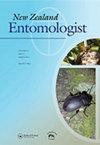1925年澳大利亚鳞翅目鳞翅目:鳞翅目鳞翅目:鳞翅目鳞翅目:鳞翅目鳞翅目:鳞翅目
IF 0.6
4区 农林科学
Q4 ENTOMOLOGY
引用次数: 2
摘要
变色是许多陆生节肢动物所表现出的一种众所周知的现象。可见表型的非随机“变形”通常与对环境的反应变化有关。这篇文章描述了一种以前未被认识到的颜色变化,它是内源性而不是外源性变化的结果:具体来说,换羽。在换毛周期中,鳞翅目的春尾鳞翅目鳞翅目的颜色表型从银灰色急剧变化为黄色,然后再变回黄色。这些颜色变化是由蜕皮期间(鳞片脱落)和蜕皮后(鳞片再生)的结构颜色(由鳞片“外衣”赋予)和角质层色素沉着之间的变化引起的。虽然变化的速度和频率受到与发育有关的外部因素(例如温度)的影响,但它是生命史的固定组成部分。颜色表型之间的差异程度意味着它们产生明显不同的视觉(因此也可能是生态)信号。据推测,当由于活动减少和角质层鳞片缺失而易被捕食时,亮黄色的亚鳞片色素沉着可能是一种警告信号。本文章由计算机程序翻译,如有差异,请以英文原文为准。
The unusually colourful ‘clothing’ changes of Lepidophorella australis Carpenter, 1925 (Collembola: Tomoceridae)
ABSTRACT Colour changing is a well-known phenomenon exhibited by a number of terrestrial arthropods. Non-random ‘morphing’ of the visible phenotype has generally been associated with changes in response to the environment. This article describes a previously unrecognised class of colour change which occurs as a result of endogenous rather than exogenous changes: specifically, moulting. The tomocerid springtail Lepidophorella australis dramatically changes its colour phenotype from silver-grey to yellow and back again during its moult cycle. These colour changes are caused by alternations between structural colouration (conferred by its ‘clothing’ of scales) and cuticular pigmentation during ecdysis (scale loss) and post-ecdysis (scale regeneration). Although the rate and frequency of change is affected by external factors related to development (e.g. temperature), it is a fixed component of life history. The extent of the difference between colour phenotypes means that they produce distinctly different visual (and presumably, therefore, ecological) signals. It is hypothesised that bright yellow subscale pigmentation may operate as a signal of aposematism when L australis are vulnerable to predation as a result of reduced activity and absent cuticular scales.
求助全文
通过发布文献求助,成功后即可免费获取论文全文。
去求助
来源期刊

New Zealand Entomologist
ENTOMOLOGY-
CiteScore
0.70
自引率
33.30%
发文量
3
审稿时长
>12 weeks
期刊介绍:
The invertebrate diversity of New Zealand is of great interest worldwide because of its geographic isolation and geological history. The New Zealand Entomologist plays an important role in disseminating information on field-based, experimental, and theoretical research.
The New Zealand Entomologist publishes original research papers, review papers and short communications. We welcome submissions in all aspects of science regarding insects and arthropods in a New Zealand or Australasian setting. The journal’s subject matter encompasses taxonomy, phylogenetics, biogeography, biological control and pest management, conservation, ecology and natural history.
The journal is the official publication of the Entomological Society of New Zealand. Papers published or submitted elsewhere for publication will not be considered, but publication of an abstract or summary elsewhere (e.g. conference proceedings) does not preclude full publication in the New Zealand Entomologist. Accepted papers become copyright of the Entomological Society of New Zealand. The journal is published in English, but we also welcome publication of abstracts in Maori.
 求助内容:
求助内容: 应助结果提醒方式:
应助结果提醒方式:


